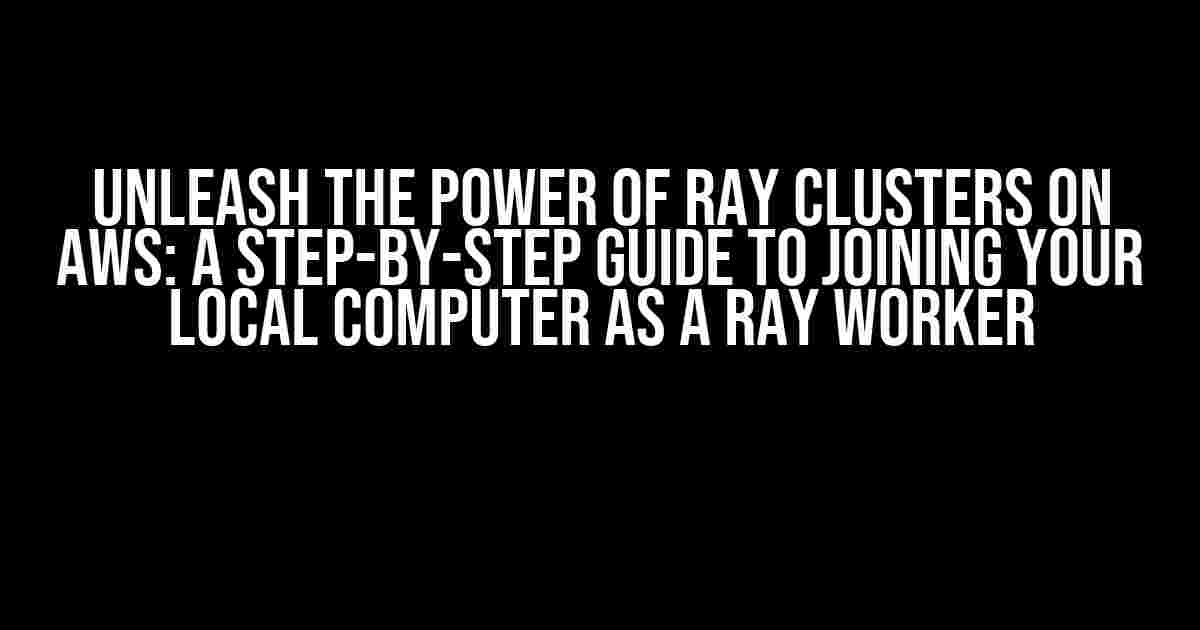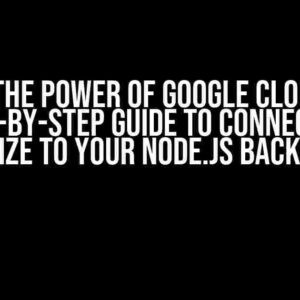Are you tired of limited computing resources holding you back from tackling complex projects? Do you want to tap into the immense power of cloud computing without sacrificing control over your local machine? Look no further! In this comprehensive guide, we’ll walk you through the process of joining your local computer as a Ray worker to an existing Ray cluster on AWS, unlocking unprecedented scalability and flexibility for your projects.
What is Ray?
Prerequisites
Before we dive into the setup process, make sure you have the following prerequisites in place:
- A functional Ray cluster on AWS (if you need help setting one up, check out our previous article)
- A local computer with a supported operating system (Windows, macOS, or Linux)
- Python 3.7 or later installed on your local machine
- The Ray library installed on your local machine (
pip install ray)
Step 1: Configure Your Local Environment
First, let’s configure your local environment to connect to your Ray cluster on AWS:
import ray
ray.init(address='auto', _node_ip_address='Your_AWS_Cluster_IP')
print('Connected to Ray cluster:', ray.cluster_info())
Replace Your_AWS_Cluster_IP with the IP address of your Ray cluster on AWS. This code snippet initializes the Ray library on your local machine and connects it to your existing cluster.
Step 2: Install Required Packages
To enable your local computer to join the Ray cluster as a worker, you’ll need to install the following packages:
ray[default](includes the necessary dependencies for Ray workers)awscli(for authenticating with your AWS account)
Use pip to install these packages:
pip install ray[default] awscli
Step 3: Configure Your AWS Credentials
To authenticate your local machine with your AWS account, create a file named ~/.aws/credentials with the following format:
[default]
aws_access_key_id = YOUR_AWS_ACCESS_KEY_ID
aws_secret_access_key = YOUR_AWS_SECRET_ACCESS_KEY
Replace YOUR_AWS_ACCESS_KEY_ID and YOUR_AWS_SECRET_ACCESS_KEY with your actual AWS credentials.
Step 4: Join Your Local Computer to the Ray Cluster
Now it’s time to join your local computer as a Ray worker to the existing cluster on AWS:
ray start --address='auto' --node-ip-address='Your_AWS_Cluster_IP' --worker
Again, replace Your_AWS_Cluster_IP with the IP address of your Ray cluster on AWS. This command starts a new Ray worker on your local machine, connecting it to the existing cluster.
Verifying Your Setup
To confirm that your local computer has successfully joined the Ray cluster, run the following command:
ray status
This command displays information about your Ray cluster, including the newly added worker node (your local computer).
Troubleshooting Common Issues
If you encounter any issues during the setup process, refer to the following troubleshooting tips:
| Error Message | Solution |
|---|---|
Failed to connect to Ray cluster |
Verify your AWS cluster IP address and ensure it’s reachable from your local machine. |
AWS credentials not found |
Check that your ~/.aws/credentials file is correctly formatted and contains valid AWS credentials. |
Ray worker failed to start |
Make sure you have the necessary dependencies installed (ray[default] and awscli) and try restarting the Ray worker. |
Conclusion
Congratulations! You’ve successfully joined your local computer as a Ray worker to your existing Ray cluster on AWS, unlocking unparalleled scalability and flexibility for your projects. With this setup, you can now harness the power of the cloud to accelerate your applications, while maintaining control over your local machine.
Don’t forget to check out our previous article for more information on setting up a Ray cluster on AWS. If you have any questions or need further assistance, feel free to ask in the comments below!
Happy computing!
Frequently Asked Questions
Get ready to dive into the world of Ray clustering on AWS with your local computer as a Ray worker!
Q1: What are the prerequisites to join my local computer as a Ray worker to a Ray cluster on AWS?
To get started, you’ll need to install Ray on your local machine, ensure you have an AWS account with the necessary credentials, and install the AWS CLI. Additionally, you’ll need to create an IAM role with the proper permissions and configure your security group to allow incoming traffic on the required ports.
Q2: How do I configure my local computer to connect to the Ray cluster on AWS as a worker?
You’ll need to set up your local machine to connect to the Ray cluster by specifying the cluster’s head node IP address, the port number, and the authentication details. This can be done by creating a `ray` configuration file or by using environment variables. Make sure to update your `ray` installation to the latest version to ensure compatibility with the AWS cluster.
Q3: What are the benefits of adding my local computer as a Ray worker to the cluster on AWS?
By adding your local computer as a Ray worker, you can scale your computation tasks more efficiently, leveraging the power of your local machine to accelerate your workflows. This hybrid approach allows you to utilize the strengths of both your local machine and the cloud-based cluster, making it an ideal solution for tasks that require heterogeneous computing environments.
Q4: How do I ensure my local computer and the Ray cluster on AWS are properly secured and authenticated?
To maintain security and authentication, make sure to use secure protocols such as TLS when communicating between your local machine and the Ray cluster. Additionally, use IAM roles and permissions to restrict access to the cluster and ensure that only authorized machines can join the cluster as workers. Regularly update your `ray` installation and dependencies to prevent vulnerabilities.
Q5: Can I use my local computer as a Ray worker with other cloud providers besides AWS?
Yes, you can use your local computer as a Ray worker with other cloud providers like Google Cloud Platform (GCP), Microsoft Azure, or even on-premises clusters. Ray is cloud-agnostic, and its worker nodes can be run on various platforms, allowing you to leverage the strengths of multiple cloud providers or on-premises infrastructure.


